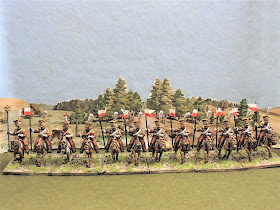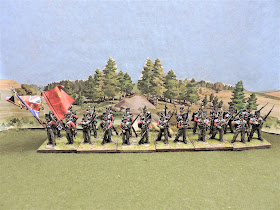 |
| (Image: 28th Regiment at Quatre Bras by Elizabeth Thompson) |
Nothing evokes the image of WAR IS GLORIOUS like the Napoleonic Wars: Soldiers in splendid uniforms marching to the beat of the drums, dashing cavalry troopers riding noble steeds, and regimental banners fluttering in the breeze.
Of course, such impressions are safely viewed from more than 202 years, after the last blast of canister mowed down the defiant Imperial Guardsmen hunkered down in their square formation during the final moments of the Battle of Waterloo.
"Merde!" indeed.
Heroic fantasies aside, the Napoleonic Wars have been, and still are, my favorite era.
However, despite my love for this period in history and fiction, I've never amassed a collection of Napoleonic miniatures. Painting such ornate uniforms requires talent and patience--both of which I lack.
Instead, I settled for buying GDW's System 7 Napoleonics. While I'm happy to have assembled the entire collection, I've always yearned to own some actual painted miniatures.
Thanks to my gaming buddy, Dean, author of the popular WAB Corner blog, my tabletop heart's desire has finally been fulfilled. Last year, he offered to sell me his collection of Napoleonic figures, all based on the rules Black Powder.
 |
| (Image by Warlord Games) |
Now without further ado, here's the latest batch of figures from my WAB Corner Collection...
The Forces of France:
The vast bulk of Napoleon's Grande Armee consisted of line infantry, which were organized into regiments consisting of several battalions.
The Black Powder rules simply refer to a group of figures as a "unit," which, for the French I'll call a battalion based on the units' flags and the typical composition of 4 x fusilier companies, 1 x grenadier company and 1 x voltigeur company.
I can now muster three battalions, the first from the 19e Regiment d'Infanterie de Ligne.
In the above picture, the grenadier company is next to the 1st company with the battalion standard, while the voltigeur company is to the right of the grenadiers, and the remaining fusilier companies are formed-up next to the voltigeurs.
My second battalion is--well--the second battalion of the 2e Regiment d'Infanterie d'Ligne.
For this picture, I used the same arrangement as I did with the 19th.
Now this last battalion surprised me.
Here we have the 4th battalion of the 9e Regiment d'Infanterie d'Ligne--in red uniforms. Meaning they're actually Swiss troops.
I didn't know Swiss troops wore red uniforms--until now. I thought they were outfitted similar, if not identical to their French counterparts.
I guess the British didn't have a monopoly on red dye during the wars.
Unlike the masses of infantry, cavalry units were much smaller, and based on the regiment. For the French I can field two regiments, the first being chasseur a cheval...
...and the second being the famous Dutch Lancers.
Based on scrolling back through our message traffic on Facebook, the French infantry came from Old Glory Miniatures, while the cavalry were made by Front Rank Figurines.
The Forces of Austria:
One of the leading antagonists against France was the Austrian Empire.
As a bonus to the French, and British figures (which follows this short section), Dean gave me his smattering of troops from the Imperial/Royal Army.
Here are a few similarly attired line infantry units with a mix of headgear. The shako replaced the helmet in 1806, but many units still sported the helmet. (Personally, I think the helmet look cooler).
Next, from left-to-right, is a stand of line infantry next to what looks like a stand of grenadiers. The figures in blue could be jaegers (light infantry).
Finally, here are two small cavalry forces. The one on the left is a small unit of cuirassiers, and the one on the right is a detachment of Hungarian hussars.
The Forces of Britain:
I have to admit when it comes to the Napoleonic Wars, I'm an Anglophile. Reading all of Bernard Cornwell's Sharpe novels only reinforced my appreciation for the Perfidious Albion's army.
Dean mustered some of the best of what Britain had to offer.
British infantry regiments were organized quite differently from their French counterparts. I regiment usually consisted of only two battalions, which often didn't serve in the same theater. Some regiments were only one-battalion strong.
This battalion-sized regiment was divided into 8 line companies, with a company of grenadiers and a company of light infantry. While these companies were smaller than their French counterparts, the British battalion/regiment had almost as many soldiers as a French battalion.
So I'll refer to my British infantry units as "regiments," starting with the first:
The Coldstream Guards, now Britain's oldest regiment.
Then there's the 71st (Highland) Regiment of Foot
To back up these two regiments, is a detachment of about three companies from the Royal Welch Fusiliers.
Here's a closer look at the Welshmen. I wonder if they're singing Men of Halrech?
And finally, no British collection would be complete without a representative from the noblest cavalry in Europe (and the worst led): In this case, the Household Cavalry.
Once again trying to piece together our year-old message traffic on Facebook, I believe the following figures came from these manufacturers:
The Household Cavalry, Royal Welch Fusiliers and the Coldstream Guards were made by Perry Miniatures, while the 71st Highlanders were from Old Glory Miniatures.
Conclusion
Well folks this wraps up my WAB Corner Collection--unless Dean sells me any more of his fine figures.
Now that I think of it, I do need some artillery to support all my troops...














Ah, a very nice walk down memory lane, Ted! You certainly know the history of this period. You got most of the manufacturers correct - the Welch Fusiliers are actually also OG, though. You now need to get a game on with these! :) Best, Dean
ReplyDeleteOh, and those small units of Foundry also include Bavarians, Italians and Swiss (yellow-coated Neuchatel Bn).
ReplyDelete